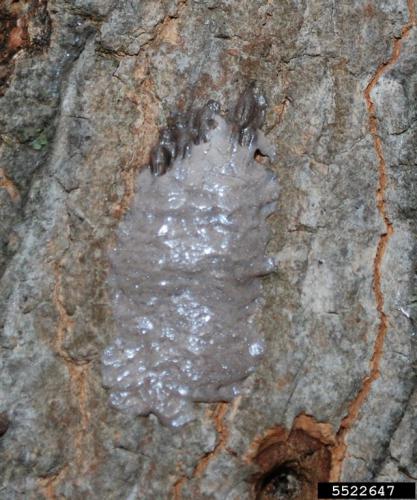Spotted Lanternfly: How big of a threat is it?
Learn more about this potential pest and many others at ANR Week’s workshop, “Addressing Threats to Michigan’s Forest Health”.

The spotted lanternfly (Lycorma delicatula) is a new invasive pest that was introduced to the United States from eastern Asia. This bug was first discovered in Pennsylvania in 2014 and has now been confirmed in 13 of that state’s counties, according to the Society of American Foresters’ Forestry Source. The Delaware Department of Agriculture recently reported collecting one adult female in their state as well. At this point, Delaware officials are uncertain as to whether this was just a single hitchhiker or the first detection of a new population. Surveys will continue in both Pennsylvania and Delaware this year.
Spotted lanternfly adults are easy to recognize because of their size, and the unique color and patterns on their wings and bodies. Adults are about one inch long, considerably larger than their native cousins in the Fulgoridae family. Their forewings are a light grey-brown with distinct black spots that transition to small speckled bands nearer the wing tips. The hind wings are eye-catching. The hind wings are a bright pink or red near the abdomen, transitioning to a white band, followed by black near the tips. Young nymphs (the immature stage) are black and white but as they grow, the nymphs turn black and red with white spots. Egg masses have a grey, waxy coating. They can be found on smooth bark of trees as well as surfaces like concrete or brick.

Egg masses are tucked under a waxy grey coating. | Photo by Pennsylvania Department of Agriculture, Bugwood.org
Why are we worried about it?
Both adults and nymphs feed by sucking sap from the woody shoots of vines or trees. They can feed on a wide range of hosts, including horticultural crops like grapevines and on the branches of apples and stone fruits. They can also feed on shoots of forest trees such as walnut, oak, pine, maple, poplar and sycamore, but to date have caused little damage. The spotted lanternflies have a particular appetite for Ailanthus or Tree of Heaven (Ailanthus altissima). In fact, they may need to feed on Ailanthus to produce viable eggs, but scientists are not entirely sure about that. Feeding lanternfly nymphs and adults excrete abundant honeydew. Not only is the honeydew sticky, it often attracts wasps and other insects, and can result in black sooty mold growth. Excessive numbers of hungry lanternflies can stress hosts by depriving them of nutrients and carbohydrates the plants need for growth and maintenance.
Want to know more?
Researchers and educators from Michigan State University Extension will be hosting a full day workshop on various forest pest and disease threats to Michigan forests. Besides the spotted lanternfly, campus specialists will be sharing the latest information on oak wilt, hemlock woolly adelgid, thousand cankers disease of walnut and other invaders. This workshop will be held on Thursday, March 8, 2018 from 9:00 a.m. until 4:30 p.m. at the Kellogg Center, East Lansing, MI. It is open to anyone concerned about forest health in Michigan, including professional foresters, natural resource agency staff, family forest owners and other interested members of the public. The $20 registration fee covers materials, parking and refreshments (lunch not included). Registration at the door will be first come first served, but refreshments and materials are not necessarily guaranteed. Visit the following site to reserve your space today: https://events.anr.msu.edu/ForHeathThreats/ .



 Print
Print Email
Email




